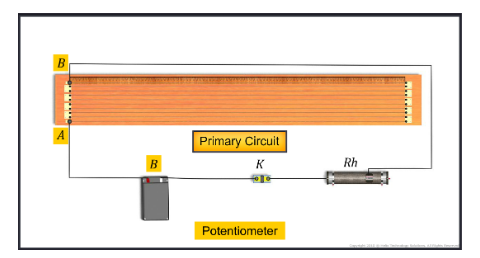Kirchoff's law and its application.
Kirchhoff’s Laws • What are Kirchhoff’s Laws?Kirchhoff’s laws govern the conservation of charge and energy in electrical circuits. • Kirchhoff’s Laws: 1. The junction rule 2. The closed-loop rule J...

The potentiometer is an accurate device that is used to measure the emf or potential difference more accurately. It is accurate than a voltmeter in the sense that the voltmeter used for measuring potential difference draws some current from the cell and hence some of the volts is lost in its internal resistance but potentiometer measures emf accurately by null deflection without drawing any current from the cell.

Principle:
If the steady current is passed through a wire having a uniform cross-section area, the potential difference across any section of that wire is directly proportional to the length of that section.
Suppose V be the potential difference between any section of a potentiometer and L be its length. Then, from the principle of potentiometer
V ∝ L
V = KL where K is proportionality constant called potential gradient.
Construction:
It consists of a long wire of 1m to 10m stretched horizontally between two points A and B alongside a meter-scale fitted over a wooden plank. A steady current is maintained and PD is measured by the null deflection method.
Applications:
a) To compare EMFs of two cells

The experimental set up is as shown in the figure. The positive terminals of two EMFs E1 and E2 are connected to point P and the next terminal is connected to a galvanometer through key K1 and K2. A jockey is connected to a galvanometer that can slide over the wire. We can adjust the steady current by adjusting the Rheostat (Rh).
When key K1 is closed and K2 is open
V1 = Kl1
E1 = Kl1 ------------ equation 1
When K2 is closed and K1 is open
V2 = Kl2
E2 = Kl2 ------------- equation 2
Dividing 1 and 2 we get,
E1/E2 = l1/l2
or, E1 = (l1/l2).E2
Thus, the EMFs of cells can be compared using a potentiometer.
b) To measure the internal resistance of a cell.

The experimental set up to measure the internal resistance of a cell is as shown in the figure. Let r be internal resistance of cells whose internal resistance is to be measured. A resistance box is connected to key K2 as shown in fig.
When key K1 is opened
V1 = Kl1
E1 = Kl1 ------- equation 1
When key K2 is closed
V2 = Kl2 ------- equation 2
Dividing 1 and 2 we get
E1/V2 = K(l1/l2) -------equation 3
We know,
E1/V1 = (R + r)/R ------ equation 4
From 3 and r
l1/l2 = 1+ (r/R)
r = R.((l1/l2)-1)
In this way we can measure the internal resistance of cell.